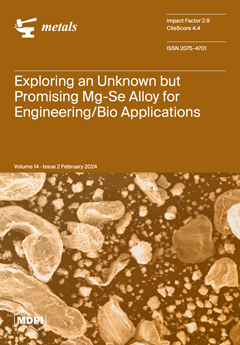Rare earth elements (REEs) and Sc are concentrated in aluminum production byproducts. The novel REEs recovery approach, which involves leaching with acid at a pH > 3 in the presence of MgSO
4, results in the formation of a pregnant leach solution
[...] Read more.
Rare earth elements (REEs) and Sc are concentrated in aluminum production byproducts. The novel REEs recovery approach, which involves leaching with acid at a pH > 3 in the presence of MgSO
4, results in the formation of a pregnant leach solution (PLS) with a low concentration of iron (Fe) and titanium (Ti) and a large number of valuable elements. This work studies the application of chelating resin Puromet MTS9580 in the sorption recovery of Sc from sulfate solutions. To analyze the static Sc sorption data, Langmuir, Freundlich, and Temkin isotherm models were used. The Langmuir isotherm model was the best fitted to the experimental data, with a coefficient of determination (R
2) of 0.983. The dynamic adsorption experiment was conducted using a PLS and a simulated solution without contaminants. Adsorption of Sc from the simulated solution was better fitted to the Thomas model with a Sc capacity greater than 6.4 mg mL
−1. Because Ti had a gradual decrease in C/C
0, which the Thomas model was unable to simulate, the modified dose-response (MDR) model fitted better with PLS with a Sc capacity greater than 3.8 mg mL
−1. The NaHCO
3 solution (200 g L
−1) effectively desorbed Sc (>98%) from simulated and PLS solutions after 1.5 h of stirring in a batch mode. After 1.5 h of desorption, the concentration of Sc in the desorption solution was 461.5 mg L
−1, while the concentration of Mg and Ti was lower than 200 mg L
−1 and 50 mg L
−1, respectively.
Full article





